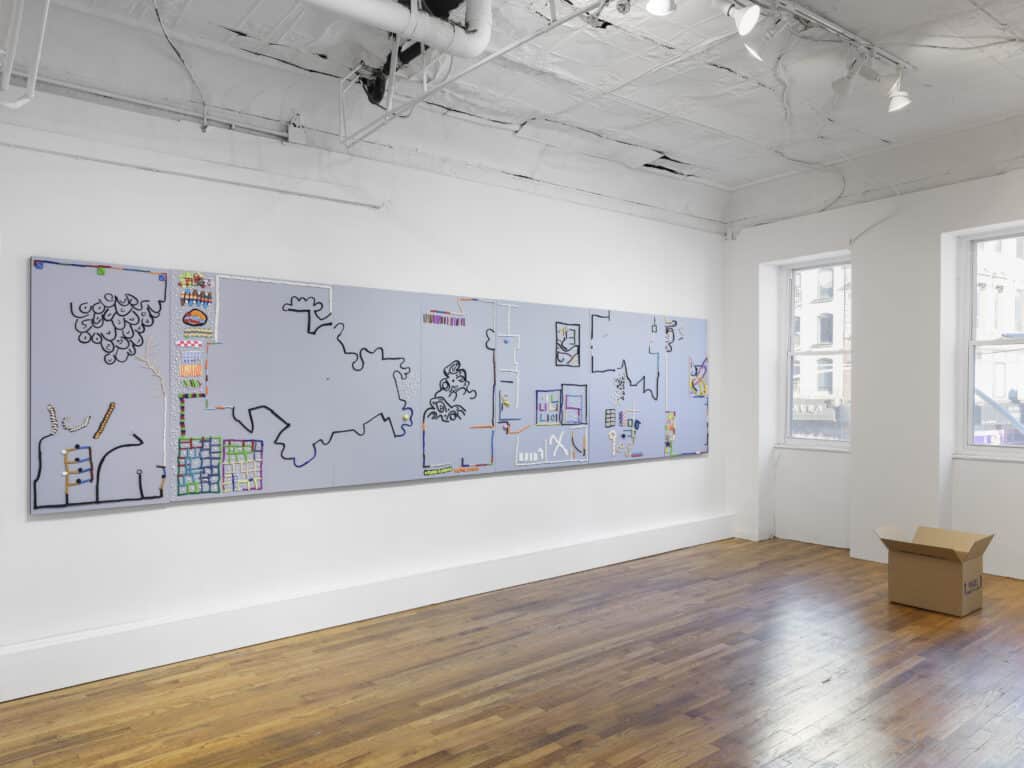Sun You: This Two

Born in Seoul, working in New York for some 20 years, Sun You is a hybrid artist making art that would fit into any of today’s major art centers, Asian or Western. Her work, quite small, mostly laid out with colorful polymer clay, and sometimes displayed in cardboard boxes (carriers of the works created by You), considers abstract patterns as the basis of her communication. The childlike aura of the materials opens up a wide accessibility to Sun You’s studied arrangement of the pieces of clay. In contemporary art, eclecticism is dominant: styles of art, differing materials, influences from cultures other than the artist’s own, all contribute to a free-wheeling aesthetic increasingly devoted to the sheer enjoyment of playful construction. The process borrows from pre-existing styles, as happens in Sun You’s art, which employs styles and materials that are not necessarily drawing from a single, identifiable tradition. Eclecticism also recognizes that art historical allusions can be rejected (or require more investigation on the part of the viewer) in favor of a kind of liberated chance, in which suggestion, rather than specific historical extrapolation, serves as the meaningful engine of the work. Sun You’s art strongly belongs to this category.
If it is difficult to bring up specific precedents that would place Sun You’s work historically. What can we do to situate her art in a fashion that would explain what we see? Looking at the artist’s haphazard use of the clay in patterns that seem arbitrary, Sun You’s audience may find that she is committed to a kind of improvisation that contemporary viewers may well have experienced before, even if her materials (the polymer clay) are unusual for art that has only been recently produced. The artist’s improvisations don’t fully neglect rational arrangement, but they do display chance in a way that undermines the rational. This is usually done structurally: sometimes the pieces are heavily compartmentalized, much as if we were looking at a simple model of an urban neighborhood. Abstraction never completely yields to the completely abstract. The clay elements of another untitled piece, placed on a support set in the upper level of a cardboard box on the floor, are colorful and thoroughly arranged. There are loops that look like thread, checkerboard patterns, and anarchic jumbles of unrelated forms, mostly set into rectangular compartments that dovetail into the larger rectangle of the box. Disarray becomes inspired in this piece, which simultaneously communicates not only the love of chance but also the deliberately arranged form as a creative stratagem; the combination of random visual events within such a grid would describe New York street life quite well.
The long, gray No Title painting (2020), extending for the length of one of the gallery walls, is embellished by polymer clay designs and doorknobs, offering what could be described as a childlike, naïve representation of the world. Not much is figuratively recognizable, though: jazzy, irregularly angled black stripes compete with taut rectangles, some of which include color (the colored clay occurs especially on the left side of the work). It is a schematic drawing that refers to no overarching pattern, yet the pleasure to be gained from what patterns there are in this painting is considerable; it is a long walk down an uncomplicated, but attractively demarcated street.
The final piece, also untitled and made in 2021, refers to a smallish work set on the mantle of the space’s fireplace. The work includes earrings, beads, razor blades, and eyelash extensions held together by magnets. Its form relates to the Japanese art of ikebana, or flower placement. The sculpture moves in the direction of inspired decoration, in which the charm of Sun You’s imagination results from a naïve perspective. It is an artist’s attempt to add some grace to what we see, even in a small gallery on the lower end of the Bowery, a neighborhood not known for its visual charm. Sun You makes a very good show out of demotic objects—wire, magnets, clay forms, cardboard—proving that works constructed from poor materials can attain an elegance we had not expected.